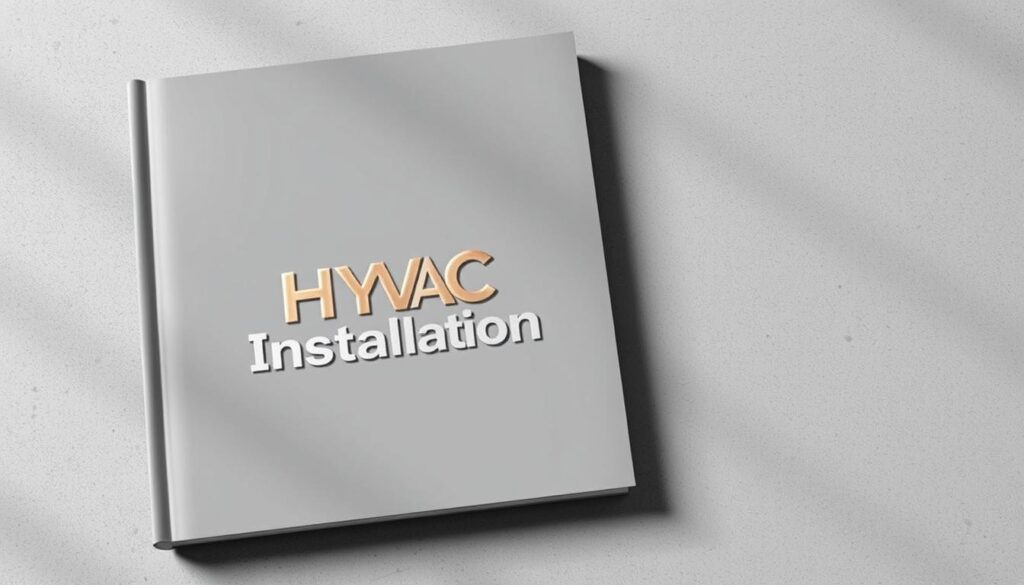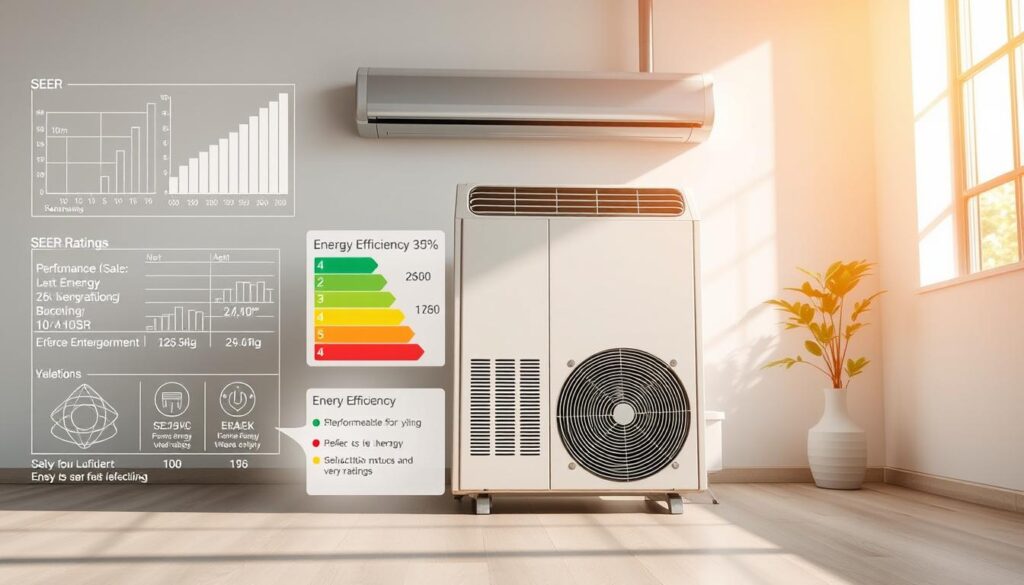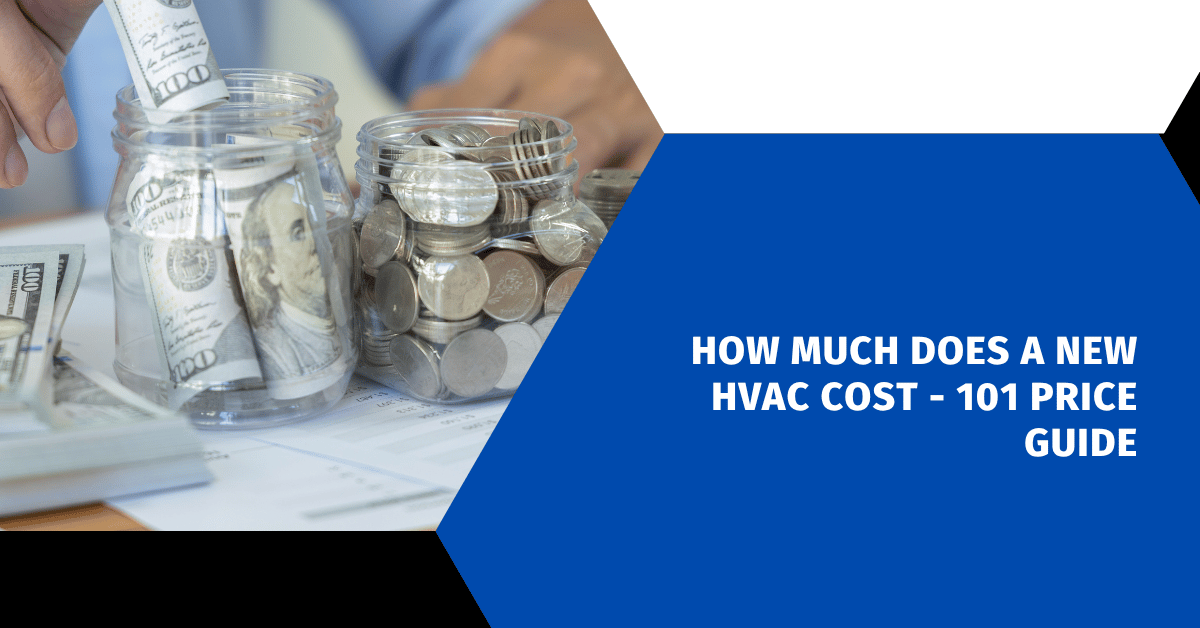Affiliate Disclosure
HVAC Guide Guys is a participant in the Amazon Services LLC Associates Program, an affiliate advertising program designed to provide a means for sites to earn advertising fees by advertising and linking to Amazon.
How Much Does a New HVAC Cost? Are you curious about the cost of a new HVAC system in 2024? Figuring out HVAC installation costs can seem overwhelming. It’s like trying to solve a puzzle with many pieces.

Homeowners usually spend between $5,000 and $12,500 for a new HVAC system. The exact cost depends on several things. These include the size of your home, the efficiency of the system, and what’s happening in your local market.
This guide will help you understand the costs of a new HVAC system. It’s designed to give you the information you need. This way, you can choose a system that fits your budget and meets your needs.
Key Takeaways
- Average HVAC replacement costs range from $5,000 to $12,500
- System efficiency significantly impacts overall installation expenses
- Home size and climate play critical roles in determining costs
- Energy-efficient systems offer long-term savings
- Professional assessment is key for accurate pricing
Table of Contents
Understanding HVAC System Basics and Current Market Prices
Choosing the right HVAC system for your home is key. You need to know the different options and their costs. The comfort of your home depends on picking the best system that fits your needs and budget.
Today, homeowners have many HVAC system choices. Each has its own features and prices. These prices can affect how much you spend.
Popular HVAC System Types
- Central Air Conditioning Systems
- Heat Pumps
- Ductless Mini-Split Systems
- Furnace and Heating Systems
Average Price Ranges by System Type
| HVAC System Type | Price Range | Average Cost |
|---|---|---|
| Central Air Conditioner (3-ton) | $4,000 – $8,000 | $5,570 |
| High-End Central Air (5-ton, 20 SEER) | $10,000 – $15,000 | $12,500 |
| Furnace (80% efficiency, 95,000 BTU) | $4,000 – $6,000 | $5,000 |
| Heat Pump (3-ton, 14 SEER) | $5,000 – $10,000 | $7,500 |
| Ductless Mini-Split (per head unit) | $2,000 – $4,000 | $3,000 |
Labor and Installation Considerations
Remember, the cost of installation is also important. It can range from $500 to $2,500. This depends on your home’s layout and the HVAC system you pick.
“Investing in the right HVAC system can save you money on energy bills and provide consistent home comfort for years to come.”
The total cost of replacing your HVAC system varies. It depends on your home’s size, the system’s complexity, and local installation rates. Talking to a professional HVAC technician can help you choose the best option for your home.
Explore Our HVAC Shop
Looking for top-rated HVAC tools, parts, and accessories? Visit our shop and find the perfect solution for your needs.
Visit the ShopHow Much Does a New HVAC Cost in 2024
Understanding residential hvac costs in 2024 requires a deep dive into current market trends. The cost of a new HVAC system varies a lot. This depends on your home’s size, the type of system, and your specific needs.
Typical hvac system pricing for homes in 2024 ranges from $5,000 to $15,000. Your total cost will depend on several important factors:
- System type and complexity
- Home square footage
- Energy efficiency ratings
- Local installation costs
Here’s a breakdown of estimated residential hvac costs by system type:
| HVAC System Type | Price Range | Average Installation Cost |
|---|---|---|
| Central Air Conditioner | $3,800 – $7,500 | $5,600 |
| Heat Pump System | $4,500 – $8,500 | $6,500 |
| Ductless Mini-Split | $2,000 – $14,500 | $8,000 |
Pro tip: Always get multiple quotes from certified HVAC professionals to ensure you receive the most accurate pricing for your specific home needs.
Remember, investing in a high-efficiency system can save you money in the long run. This can help offset the initial cost over time.
Factors Affecting HVAC Installation Costs
Understanding the costs of commercial HVAC systems involves looking at several key factors. The price of your HVAC system isn’t random. It’s influenced by many complex considerations that can affect your expenses.
Choosing the right HVAC system means carefully considering several important factors. These factors determine the total cost of your investment. Let’s look at the main elements that affect your pricing.
Home Size and System Capacity Requirements
The size of your home affects the capacity of your HVAC system and its cost. It’s important to match your home’s size with the system’s capacity. This ensures your system works well and uses energy efficiently.
- 1,000-1,500 sq ft: Typically requires a 2-ton system
- 1,500-2,000 sq ft: Usually needs a 3-ton system
- 2,000-2,500 sq ft: Might require a 4-ton system
Energy Efficiency Ratings Impact
Higher efficiency ratings mean higher initial costs but save money in the long run. SEER ratings are key in determining your system’s value.
| SEER Rating | Efficiency Level | Estimated Annual Savings |
|---|---|---|
| 13-14 | Standard Efficiency | Base Performance |
| 15-16 | High Efficiency | $100-$200/Year |
| 17-21 | Premium Efficiency | $200-$400/Year |
Geographic Location and Climate Considerations
Your local climate greatly affects HVAC costs. Areas with extreme temperatures need stronger systems. This can raise installation costs.
- Southern states: Higher cooling capacity needed
- Northern states: Enhanced heating capabilities essential
- Coastal areas: Corrosion-resistant materials recommended
By understanding these factors, you can make a smart choice. This choice balances initial costs with long-term savings and performance.
Explore Our HVAC Shop
Looking for top-rated HVAC tools, parts, and accessories? Visit our shop and find the perfect solution for your needs.
Visit the ShopEnergy Efficiency and SEER Ratings Explained

Choosing an energy-efficient HVAC system is key. SEER (Seasonal Energy Efficiency Ratio) ratings show how well your system works. They also affect the cost of your HVAC unit.
SEER ratings measure cooling efficiency. It’s like miles per gallon for your car. The higher the number, the better the system. Today’s top systems have SEER ratings from 14 to 26.
- SEER 14-15: Minimum efficiency standard
- SEER 16-20: High-efficiency systems
- SEER 21-26: Premium energy-saving models
Where you live affects SEER ratings. In warmer places, like the southeast, systems need to be more efficient. Getting a higher SEER rating might cost more upfront. But, it can save you a lot on energy bills over time.
| SEER Rating | Energy Efficiency | Estimated Annual Savings |
|---|---|---|
| 14 | Standard | Baseline |
| 16 | High | $100-$200 |
| 20+ | Premium | $300-$500 |
When looking at energy-efficient HVAC options, think about your area, home size, and budget. A pro HVAC contractor can guide you to the best system for your needs.
Installation Requirements and Timeline
When planning your HVAC costs, it’s key to understand the installation process. Professional installation needs careful planning and following local rules. This ensures your system works well and lasts long.
Before starting your HVAC installation, you’ll face several important steps. These steps affect the overall cost of installation:
Permit and Inspection Essentials
Local laws often require specific steps for HVAC replacements. Here’s what you need to know:
- Get the needed building permits
- Book mandatory inspections
- Check if your contractor is licensed
Permit costs vary, from $100 to $300, based on where you live. Your licensed contractor will handle these tasks.
Professional Installation Process
The HVAC installation process includes several detailed steps:
- First, a home assessment
- Choosing the right equipment
- Removing the old system
- Installing the new system
- Adjusting the ductwork
- Testing the system
Project Duration Expectations
Residential HVAC costs and how long it takes vary. Most installations take 1-3 days. The size of your home, the type of system, and ductwork changes affect the project’s length.
Choosing a certified professional is important. It ensures your system meets all standards and local codes. This protects your investment and keeps warranties valid.
Explore Our HVAC Shop
Looking for top-rated HVAC tools, parts, and accessories? Visit our shop and find the perfect solution for your needs.
Visit the ShopComparing Different HVAC Brands and Models
Choosing the right HVAC brand is key to your home’s comfort and efficiency. The market has many top brands known for their quality and performance.
The cost of your HVAC system depends on the brand and its features. Some brands are known for their high-quality systems:
- Trane: Known for durability and advanced technology
- Carrier: Offers high-efficiency systems with innovative designs
- Lennox: Recognized for exceptional energy-saving models
- Rheem: Provides reliable and cost-effective solutions
| Brand | Average Price Range | Efficiency Rating | Warranty Coverage |
|---|---|---|---|
| Trane | $5,000 – $10,000 | Up to 22 SEER | 10-year limited |
| Carrier | $4,500 – $9,500 | Up to 21 SEER | 10-year limited |
| Lennox | $5,200 – $10,500 | Up to 26 SEER | 5-10 year limited |
Choosing a well-known HVAC brand can save you money over time. Cheap options might seem good at first, but they often don’t last or work as well.
Look at more than just the price when comparing brands. Consider energy efficiency, noise, features, and warranties. Your home’s needs and local climate will help you choose the best HVAC system.
Financing Options and Available Incentives
Getting a new HVAC system can cost a lot. But, there are many financing plans and energy-efficient options to help. Knowing about these can help you choose wisely, balancing comfort and cost.
Government Tax Credits
The government has great tax incentives for energy-efficient HVAC choices. These can cut down your costs a lot:
- Up to 30% tax credit for qualifying heat pump systems
- Credits for high-efficiency air conditioners and furnaces
- Potential savings of $2,000 or more on your tax return
Manufacturer Rebates
Many HVAC makers offer special deals to help with the cost. These rebates can be from $100 to $1,500, depending on the system and maker.
“Investing in energy-efficient technology is not just about saving money, but also about reducing your environmental footprint.” – Energy Star Representative
Payment Plans and Financing Terms
When looking at HVAC financing, consider these:
- Manufacturer-backed financing with low introductory rates
- Home improvement loans with flexible terms
- Credit card promotions with 0% interest periods
Pro tip: Always compare multiple financing options to find the most cost-effective solution for your budget and energy needs.
Explore Our HVAC Shop
Looking for top-rated HVAC tools, parts, and accessories? Visit our shop and find the perfect solution for your needs.
Visit the ShopLong-term Cost Benefits and Energy Savings

Choosing energy-efficient HVAC systems can change your home’s comfort and wallet. The upfront cost might seem steep, but the long-term savings are huge. Today’s HVAC systems are made to use less energy and cut down on your bills.
When looking at hvac costs, remember these big savings:
- Lower monthly energy bills
- Less money for upkeep
- Chances for tax breaks and rebates
- More value for your home
High-efficiency systems often pay off big time. A system with a higher SEER rating can save you 20-30% on energy costs compared to older models.
| SEER Rating | Estimated Annual Savings | Payback Period |
|---|---|---|
| 13-14 SEER | $100-$200 | 5-7 years |
| 16-18 SEER | $250-$400 | 3-5 years |
| 20+ SEER | $500-$700 | 2-4 years |
Your local weather and energy prices affect how much you’ll save. Talking to an HVAC expert can guide you to the best energy-saving HVAC choices for your home.
Conclusion
Figuring out the cost of a new HVAC system involves looking at several factors. Your home’s size, energy goals, and budget are key. Professional contractors can guide you through this, giving advice tailored to your needs.
When you’re upgrading your HVAC, think beyond the initial cost. Energy-saving systems might cost more upfront but save you money in the long run. Look into different brands, compare their performance, and get detailed quotes from trusted HVAC experts.
Your HVAC system is vital for your home’s comfort and energy efficiency. Knowing about costs, looking into financing, and focusing on energy savings are smart moves. Take the time to understand what you need and ask for expert advice during the replacement process.
A well-thought-out HVAC replacement can make your home more comfortable, use less energy, and give you peace of mind. Use the tips from this guide to confidently plan your HVAC upgrade.

